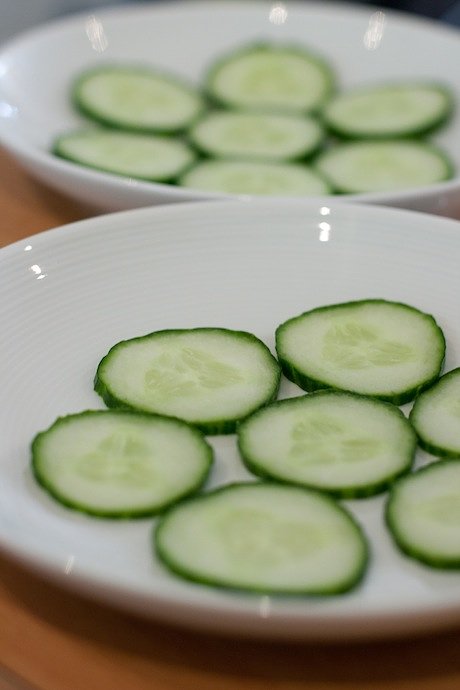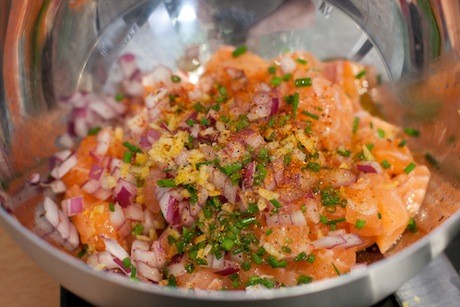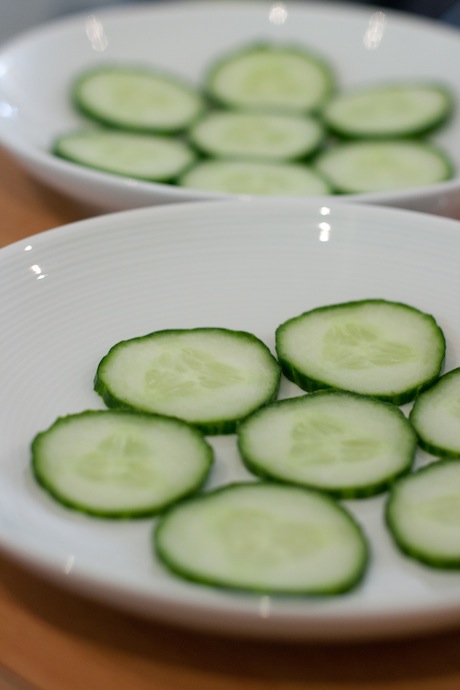Tartare de Saumon with Piment d'Espelette

Mon 27 Aug 2012

Tartare de saumon (salmon tartare) is a great example of a modern classic that features regularly on the menu of Paris bistros. It’s a much lighter alternative to its equally delicious but much heavier beef counterpart—tartare de boeuf—and is particularly delightful enjoyed on a shady terrace with a crisp white wine at the height of summer (and even in the depths of winter, if we’re being entirely honest with ourselves). The popularity of tartare de saumon is also evidenced in the plethora of recipes found in the pages of French cooking magazines!
This dish, which can be on the table in less than 15 minutes, involves combining cubed pieces of raw salmon with a few key items, such as finely chopped onions and fresh herbs. And that’s it. But don’t let the simplicity fool you: tartare de saumon, like it’s beefy cousin, is actually quite complex. Whereas various forms of cooking can hide the flaws in certain cuts of meat or other ingredients, this dish is served raw, so you need to use the best and freshest ingredients you can find, and presentation is everything. Shining fillets of salmon bought at the market that morning, chives just plucked from the garden, lemons from a roadside fruit stand and the tiniest hint of bright red chili flakes.

A typical steak tartare often uses Tabasco to heighten the flavors, but this can be a little too overpowering with fish. The ingredient that pulls all the flavors together and adds just the tiniest bit of heat to the recipe is piment d’Espelette, a mild red chili that enjoys appellation d’origine contrôlée (AOC), or controlled destination of origin, status. It is grown only in the area surrounding the town of Espelette in the Basque region of France, and has gained a great deal of popularity since receiving AOC status in 2000. Little jars of this ground chili can easily be found at specialty stores and many supermarkets. Because it is not particularly fiery (and was actually used as an alternative to pepper in the Basque region for many years), it goes extremely well with fish and other delicate flavors, and really kicks the already elegant tartare de saumon up a notch.

With a delightful splash of color on the plate and a tiny bit of unexpected zing, this is a modern French dish that will really impress guests—or at least those who are game enough to enjoy raw fish!
Tartare de Saumon with Piment d’Espelette
Serves 2.
2 salmon fillets, 150 grams each
4 baguette slices
1 avocado, diced
1 1/2 tablespoons chives, finely chopped
1 1/2 tablespoons lemon juice
1/4 cucumber, cut into about 14 slices
1 1/2 tablespoons red onion, finely chopped
a pinch of black pepper
a pinch of fleur de sel
1/4 teaspoon piment d’Espelette
1/4 teaspoon mustard
1 teaspoon lemon zest
1 tablespoon olive oil
1. Cut the salmon fillets into small cubes, about 1–2 centimeters in diameter. Cover and refrigerate immediately.
2. Toast the baguette slices, then set them aside.
3. Combine the avocado, 1/2 tablespoon chives and 1/2 tablespoon lemon juice, then set aside.
4. Divide the cucumber slices between two small plates, arranging them to form a circle.
5. Combine the salmon, the rest of the chives, red onion, pepper, salt, piment d’Espelette, mustard, lemon juice, lemon zest and olive oil together, then set aside.
6. Place a ring mold (or a large round cookie cutter if you’re in a pinch) in the center of the cucumber slices and spoon half the avocado mixture into the mold. Press the avocado gently to cover the base. Spoon half the salmon mixture on top of the avocado and press very gently to set everything into place. Carefully remove the ring mold and repeat on the other plate.
7. Decorate with an extra sprinkle of piment d’Espelette and serve immediately, with the toasted baguette slices.
Extra notes: The quality of the salmon is extremely important. Be sure to get the freshest fillets from your trusted fishmonger to prevent any bacterial risk, and use them on the day of purchase. If you want to make this ahead of time, prepare all the ingredients an hour or so in advance, but keep them all separate. If you combine the tartare ingredients too early, the onion will overpower everything and the lemon will begin to “cook” the salmon—you want all the ingredients to meet each other only at the very last minute, on the plate.
Editor’s note: If you are a foodie heading to Paris, why not download one of our three gourmet walking trips or our package of foodie walks for the iPhone?